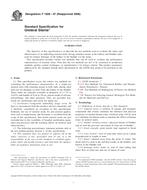Potřebujeme váš souhlas k využití jednotlivých dat, aby se vám mimo jiné mohly ukazovat informace týkající se vašich zájmů. Souhlas udělíte kliknutím na tlačítko „OK“.
ASTM F2624-12
Standard Test Method for Static, Dynamic, and Wear Assessment of Extra-Discal Single Level Spinal Constructs
Automaticky přeložený název:
Standardní zkušební metoda pro statická, dynamická a opotřebení Hodnocení Extra-Discal jedné úrovni Spinální konstrukty
NORMA vydána dne 1.12.2012
Informace o normě:
Označení normy: ASTM F2624-12
Poznámka: NEPLATNÁ
Datum vydání normy: 1.12.2012
Kód zboží: NS-54268
Počet stran: 16
Přibližná hmotnost: 48 g (0.11 liber)
Země: Americká technická norma
Kategorie: Technické normy ASTM
Kategorie - podobné normy:
Anotace textu normy ASTM F2624-12 :
Keywords:
posterior instrumentation, spinal implant, wear assessment, weight loss method, ICS Number Code 11.040.40 (Implants for surgery, prothetics and orthotics)
Doplňující informace
| Significance and Use | |||||||||||||||||||||||||||||||||
|
This test method is designed to quantify the static and dynamic characteristics of different designs of single level spinal constructs. Wear may also be assessed for implants that allow motion using testing medium (see 6.1) for simulating the physiologic environment at 37°C. Wear is assessed using a weight loss method in addition to dimensional analyses. Weight loss is determined after subjecting the implants to dynamic profiles specified in this test method. This information will allow the manufacturer or end user of the product to understand how the specific device in question performs under the test conditions prescribed in this test method. This test method is intended to be applicable for single level extra-discal spinal constructs. Three different types of fixtures are specified for testing single level extra-discal spinal constructs (See Fig. 2, Fig. 4, and Fig. 5). See also Table 1. Implants may be designed using a variety of materials (for example, ceramics, metals, polymers, or combinations thereof), and it is the goal of this test method to enable a comparison of the static, dynamic, and wear properties generated by these devices, regardless of material and type of device. TABLE 1 Loading Modes and Associated Apparatus Listing Possible Tests That May Be Conducted (see 1.9) Note 1—For all loading modes, static, dynamic, and wear tests are described in this test method. Note 2—“Offset” refers to 8 mm of offset induced in the spinal construct (see Fig. 6) before subjecting the construct to rotational flexion/extension moments (see Fig. 2).
|
|||||||||||||||||||||||||||||||||
| 1. Scope | |||||||||||||||||||||||||||||||||
|
1.1 This test method describes methods to assess the static and dynamic properties of single level spinal constructs. 1.2 An option for assessing wear using a weight loss method and a dimensional analysis is given. This method, described herein, is used for the analysis of devices intended for motion preservation, using testing medium as defined in this standard (6.1). 1.3 This test method is not intended to address any potential failure mode as it relates to the fixation of the device to its bony interfaces. 1.4 It is the intent of this test method to enable single level extra-discal spinal constructs with regard to kinematic, functional, and wear characteristics when tested under the specified conditions. 1.5 This test method is not intended to address facet arthroplasty devices. 1.6 In order that the data be reproducible and comparable within and between laboratories, it is essential that uniform procedures be established. This test method is intended to facilitate uniform testing methods and data reporting. 1.7 The motion profiles specified by this test method do not necessarily accurately reproduce those occurring in vivo. Rather this method provides useful boundary/endpoint conditions for evaluating implant designs in a functional manner. 1.8 This test method is not intended to be a performance standard. It is the responsibility of the user of this test method to characterize the safety and effectiveness of the device under evaluation. 1.9 Multiple test methods are included in this standard. However, it must be noted that the user is not obligated to test using all of the described methods. Instead, the user should only select test methods that are appropriate for a particular device design. In most instances, only a subset of the herein described test methods will be required. 1.10 The values stated in SI units are to be regarded as the standard with the exception of angular measurements, which may be reported in either degrees or radians. No other units of measurement are included in this standard. 1.11 This test method does not purport to address all of the safety concerns, if any, associated with its use. It is the responsibility of the user of this test method to establish appropriate safety and health practices and to determine the applicability of regulatory limitations prior to use. |
|||||||||||||||||||||||||||||||||
| 2. Referenced Documents | |||||||||||||||||||||||||||||||||
|
Podobné normy:
Historická
1.8.2004
Historická
1.2.2009
Historická
1.2.2013
Historická
1.3.2006
Historická
1.2.2009
Historická
1.3.2006



 ASTM F1801-97(2009)e..
ASTM F1801-97(2009)e.. ASTM F1814-97a(2009)..
ASTM F1814-97a(2009).. ASTM F1820-13
ASTM F1820-13 ASTM F1828-97(2006)..
ASTM F1828-97(2006).. ASTM F1829-98(2009)..
ASTM F1829-98(2009).. ASTM F1831-97(2006)..
ASTM F1831-97(2006)..
 Cookies
Cookies
